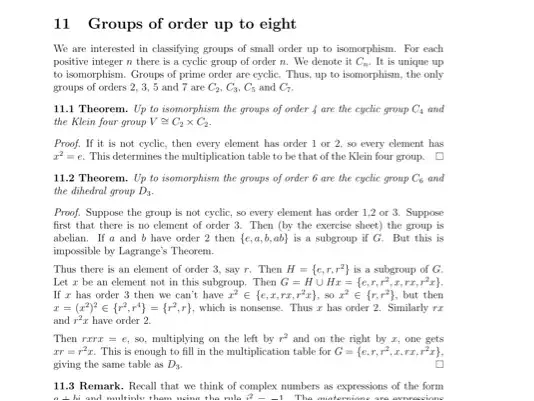The following image shows a screenshot from a page of my lecture notes:

As you can see, it keeps using the expression "up to isomorphism", but doesn't explain what this means. Can anyone tell me what this means in this context?
Thanks
The following image shows a screenshot from a page of my lecture notes:

As you can see, it keeps using the expression "up to isomorphism", but doesn't explain what this means. Can anyone tell me what this means in this context?
Thanks
Ok, let's take an example from those notes.
It says "Up to isomorphism, the groups of order $6$ are the cyclic group $C_{6}$ and the dihedral group $D_{3}$."
This means if $G$ is any group of order $6$, it must be the case that either $G$ is isomorphic to $C_{6}$ or to $D_{3}$. $G$ might be a completely different set living in a completely different universe than either $C_{6}$ or $D_{3}$, but we are assured by the theorem that regardless of this fact, the behavior of the elements of $G$ will either be exactly like those of $C_{6}$ or those of $D_{3}$.
That's what the word isomorphism means, anyway. If two groups $G$ and $H$ are isomorphic, they could live in completely different universes and have totally different looking elements and different operations. But we are assured that there is some way to identify the elements of $G$ and $H$ in a one-to-one correspondence so that they look and behave exactly like the same group, even though they superficially look different.
This just means that the only groups you can have will be isomorphic to one given. Notice that we can define the "same" group simply be renaming its elements but in that case it is not the same group, but is isomorphic. This is all this accounts for and in algebra is what we think of as "equality".
Say you want to classify groups of order one. For any set with one element, there is a unique group structure on it. So every set with one element can be made into a group with one element in a unique way. In a manner of speaking, that means there is a group of order one for every possible "thing" that can be in a set. There is "too infinitely many things" to consider here - there is no set of all groups of order one, they instead form a "proper class." But intuitively, all of these groups of order one are "the same group," just as two giraffes are the same animal, and the psychological act of thinking of isomorphic groups as "the same group" is treating groups "up to isomorphism."
Here is an example. For every $a\ne b\in \mathbb R$, let $G_{(a,b)}$ denote the set $$\{a,b\}$$equipped with the binary operation $*_{(a,b)}$ given by$$a\ *_{(a,b)}\ a=a\\a\ *_{(a,b)}\ b=b\\b\ *_{(a,b)}\ a = b\\b\ *_{(a,b)}\ b=a$$
A simple check shows that this turns $(G_{(a,b)},*_{(a,b)})$ into a group of order $2$ with identity $a$.
But group theoretically, these groups are all exactly the same. They have the same order, their elements have the same structure - everything about their group structure is identical. Effectively these groups are all exactly the same, except we've called them and their elements different names.
This "sameness" is captured by the idea of isomorphism. If $a',b'\in \mathbb R$, then there is an isomorphism $$G_{(a,b)}\to G_{(a',b')}\\a\mapsto a'\\b\mapsto b'$$
Saying that we want to classify all groups "up to isomorphism" means, for example, that we consider all the $G_{(a,b)}$ to be the same group. Since it is the group structure that we're interested in, it makes sense to consider all the $G_{(a,b)}$ as the same group, because they are all isomorphic. It turns out there is exactly one group structure that can be given to a set with $2$ elements.